
A MONTH WITH THREE INITIATES DURING THE XHOSA CIRCUMCISION RITUAL

The male initiation ceremony of the Xhosa people of South Africa, Ulwaluko, is an age-old tradition. It’s a mystical, secretive ritual that occurs far away from the eyes of the public. The only information non-participants and non-family members ever have about it is the disturbing death toll from what the newspapers call botched circumcisions. As a result, there is pressure from some quarters to ban the custom altogether.
And, as winter approaches and a new crop of abakwetha are preparing to ‘go to the mountain’ to earn the right to call themselves men, the controversy is bound to resurface. But, having spent the 2014 winter season filming a documentary with three abakwetha, I can testify that the ceremony is a test of courage and is much more than a circumcision ritual.
Banning it is a ridiculous notion. Ulwaluko is fundamental to Xhosa life
I think banning it is a ridiculous notion. Ulwaluko is fundamental to Xhosa life, but it’s not a rigid, inflexible ritual. It changes with the times. For example, the abakwetha no longer actually go to the mountains, but somewhere close by yet cut off from the village. And the seclusion period is much shorter. When 63-year-old Bangile Pakamile went through initiation he was away for six months, and his younger brothers, who are in their forties, spent three months in seclusion. Now their sons Sandile and Anathi, and their close friend Lulama, will spend one month in the bush.
There are two seasons for the Ulwaluko – winter and summer. Despite village elders murmuring, ‘we had it harder’, the month in the bush is not easy, particularly in winter. Every boy knows the inherent dangers – the number of deaths mounts up on the front pages like a recurring nightmare. Indeed, by the time Sandile, Nathi and Lulama had safely stepped out as new men, 39 initiates had died in the Eastern Cape, and more than 300 had been hospitalised.
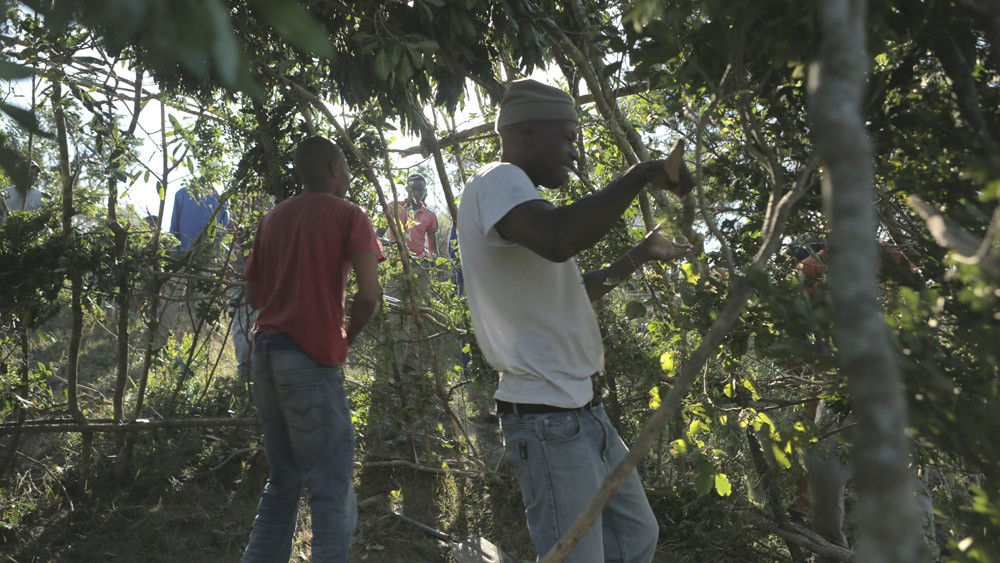
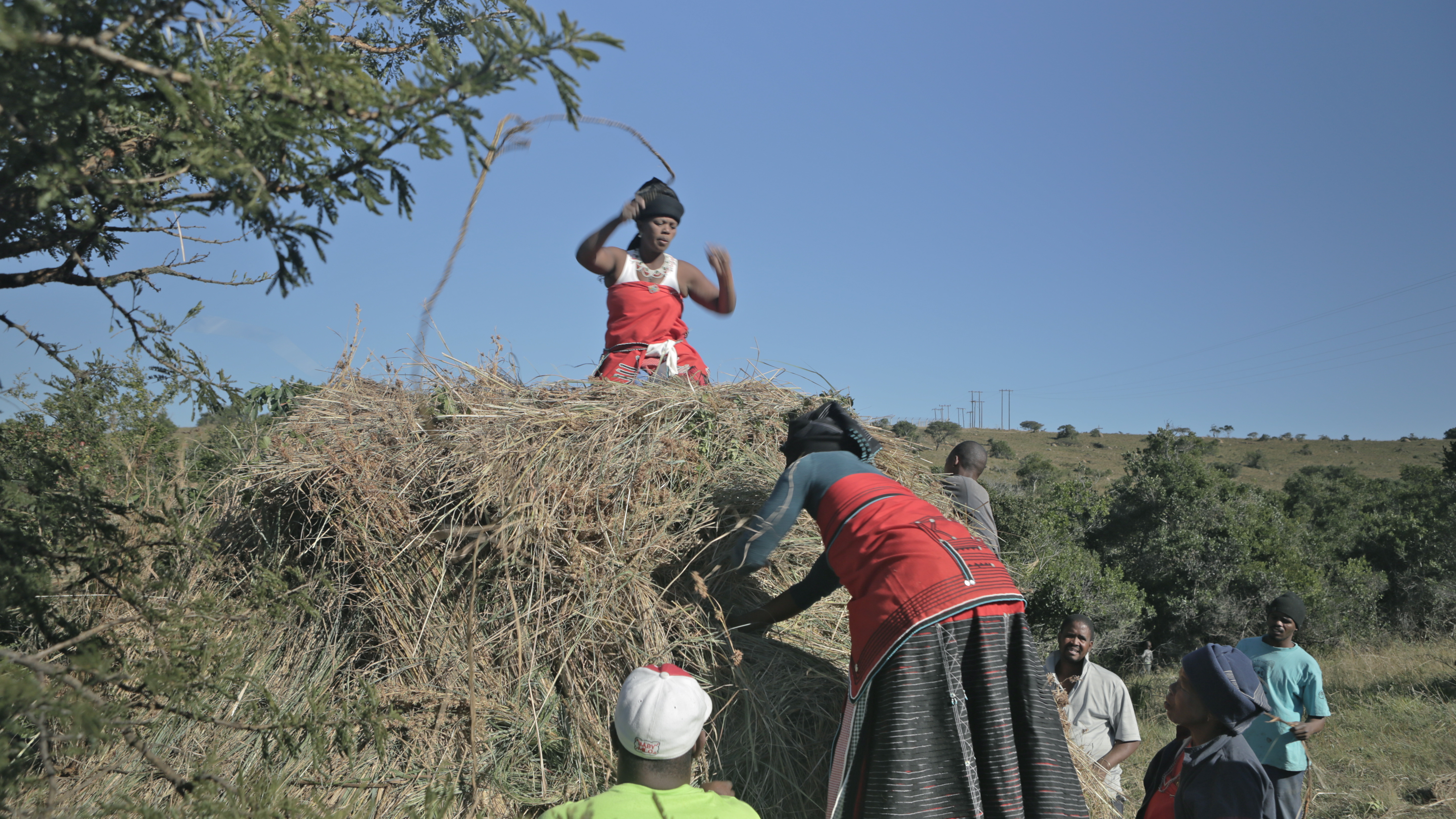
The number of deaths mount up on the front pages like a recurring nightmare
The initiates, known collectively as abakwetha or individually as umkwetha, surrender their names. Their clothes are shredded in the days leading up to their exclusion, and they carry a short stick with a white cloth tied to one end. Women cut dry grass for thatching while men chop down flexible saplings. Dressed in traditional clothing, the adults construct a domed dwelling called iboma that will serve as the home for the abakwetha. Each of the customs is intricate and detailed, but there is no instruction booklet, so the men constantly remind each other of the many important details as the preparation continues.
The structure is surrounded by a symbolic barrier of thorn branches with a single entry and exit point. One member of the construction crew accidentally stepped across the thorn branches and was scolded by one of the elders. His indiscretion was probably due to ceremonial brandy rather than a failure to adhere to traditional guidelines. Alcohol has woven its way into every stage of the ceremony. Where traditional beer known as umqombothi might have once served a role, brandy and Castle Lager have been added. I find myself included in this custom, and a bottle of brandy is requested from me. All those present contribute in one way or another. The greatest contribution comes from the parents of the initiate. By my calculations, it costs somewhere in the region of ZAR10,000 (US$900) to put a boy through the initiation. There are cows and at least two goats to slaughter, traditional blankets, a month’s worth of food, traditional surgeon fees, overseer fees and food and drinks for parties. And the brand new smart clothes worn at the end of the month can cost in excess of ZAR2,000 alone. It’s a significant burden on already financially stretched families.

Buttons with no holes
John Pakamile, a 20-year veteran overseer of the initiates, tells me that the early white settlers brought two things to the Xhosa people. Alcohol and buttons with no holes. I sat dumbfounded, pondering ‘buttons with no holes’. John laughed at me and said: ‘We had everything we needed. Fresh water from the rivers, wild animals to hunt, livestock and gardens – what use did we have for money?’
For rural people far away from industrial and commercial centres, making ‘buttons with no holes’ is a constant struggle. But despite the economic hardships, many live full and dynamic lives filled with humour, warmth, love and generosity. It is a close community, and participation in the Ulwaluko involves every member of the wider family group and friends. While elders ensure practices are correctly adhered to, five or six younger boys will be in constant attendance at the abakwetha. Delighting in their role as inqalathi, the young boys chop wood from the nearby forest and begin making a pile of firewood outside the entrance to the iboma.
To comply with regulations governing traditional circumcision initiates must be at least 18 years of age and must present written parental or guardian consent to the central office of records for initiates. The initiates, the traditional surgeon, and the overseer must all be registered and have the necessary permits. There are actually traditional police who visit during the season demanding the official papers, which are kept in a plastic sleeve and tucked up into the thatching of the iboma. Failure to comply may result in fines and/or prison.
At the office of records, we met with the traditional surgeon. Although the circumcision is still done with an assegai (spear), I am assured by John that hygiene standards are rigorous. For two initiates, the spear has two sharp blades, one on each end. For three initiates, the surgeon brings two spears. The surgeon is an outsider who only appears for the removal of foreskins. He attends to all the initiates in the area and, thankfully, is not a participant in alcohol-related rituals at any time.

Going to the mountain
When the big day arrives for Sandile, Anathi and Lulama there is a huge gathering at the family homestead. The abakwetha are stripped naked and ushered inside the family kraal (traditionally a collection of huts within an enclosure). They sit on the bare ground draped in grey blankets while a cow and goat are slaughtered. There is a great deal of alcohol consumed by those in attendance, especially the old men who sit looking on from a semi-circle of chairs. Axes and knives flash in the winter sun as the animals are butchered, cooked in big pots, and then rapidly consumed by all.
All the while, in the swirl of dust, blood and noise, the abakwetha sit quietly with heads bowed in submission while attending men explain what is to come and what is expected of them. Their heads and pubic hair are shaved. They are offered choice cuts of goat and cow and encouraged to fill up.


They find the surgeon waiting for them in the bush with spear in hand
At dusk, all the men rise and encircle the abakwetha, singing an immensely powerful song. They slowly shuffle and dance along the road while the entire village ululates and shouts. The energy in the group feels edgy and somewhat dangerous. The men carry an assortment of sticks, and small scuffles break out as they near the edge of the village. Suddenly the three abakwetha drop their blankets and run for their lives as the men tear after them, shouting and wielding their sticks. It must have their teenage hearts beating out of their chests.
Having escaped one terror, they find the surgeon waiting for them in the bush with a spear in hand. They sit down with legs apart, and a rapid single cut from the assegai removes the foreskin. The boys make no sound; they don’t flinch, stoic bravery being an important part of this and the hurdles to come. Their wounds are dressed with a medicinal plant called izichwe and tied with a leather thong around their waists. There is only a small group in attendance, and in the fading light, I can just see one of the boys’ shoulders rise as the thong is pulled taut, but he makes no sound.
The white cloth tied to the stick that they carried is thrown high into the air, a signal that it is done. A collective cry from the village follows – it is the last time the women will see or hear anything of the abakwetha for a month.
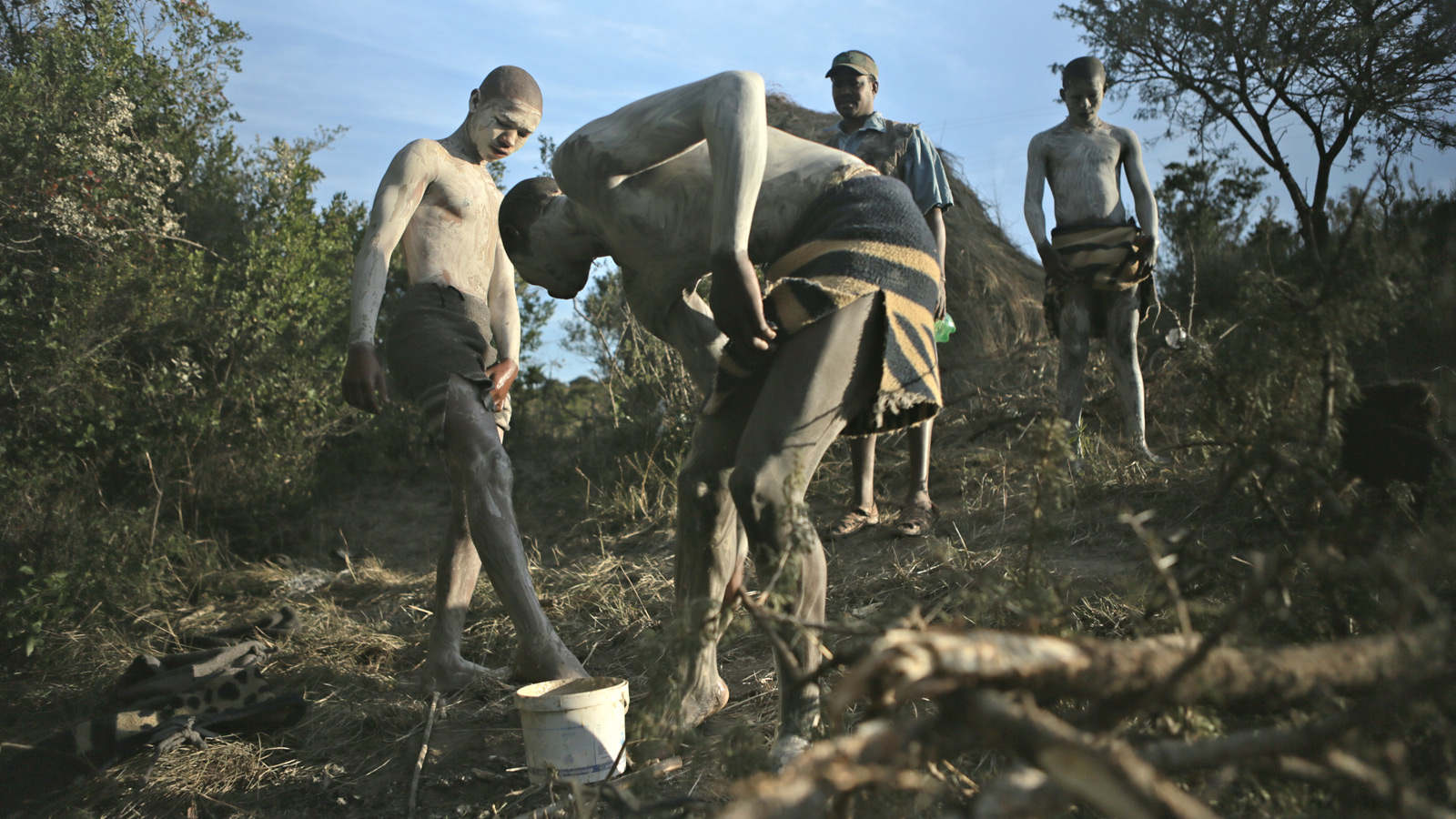
Seven days of pain and hunger
The abakwetha are understandably in great pain and discomfort for the first few days. They eat only half-boiled maize and no water for seven days. They have a blanket and a little straw between them and the cold earth. The little inqalathi are their lifesavers keeping the fire burning through the night. It’s freezing cold, and the abakwetha lie with their knees raised, progressively weakening as the days go by.
Their overseer John Pakamile shows them how to dress the wounds with ischwe leaves, visiting them up to four times a day during this critical time. After five days, John covers their faces, arms and legs in the white clay of the initiate. It is supposed to keep them warm and protect their skin from the sun, but no deeper meaning is forthcoming. The initiates must keep up this application of white clay or be punished. They are also given beautiful white blankets with red stripes and sit silently in the sun as John delivers the next set of instructions.

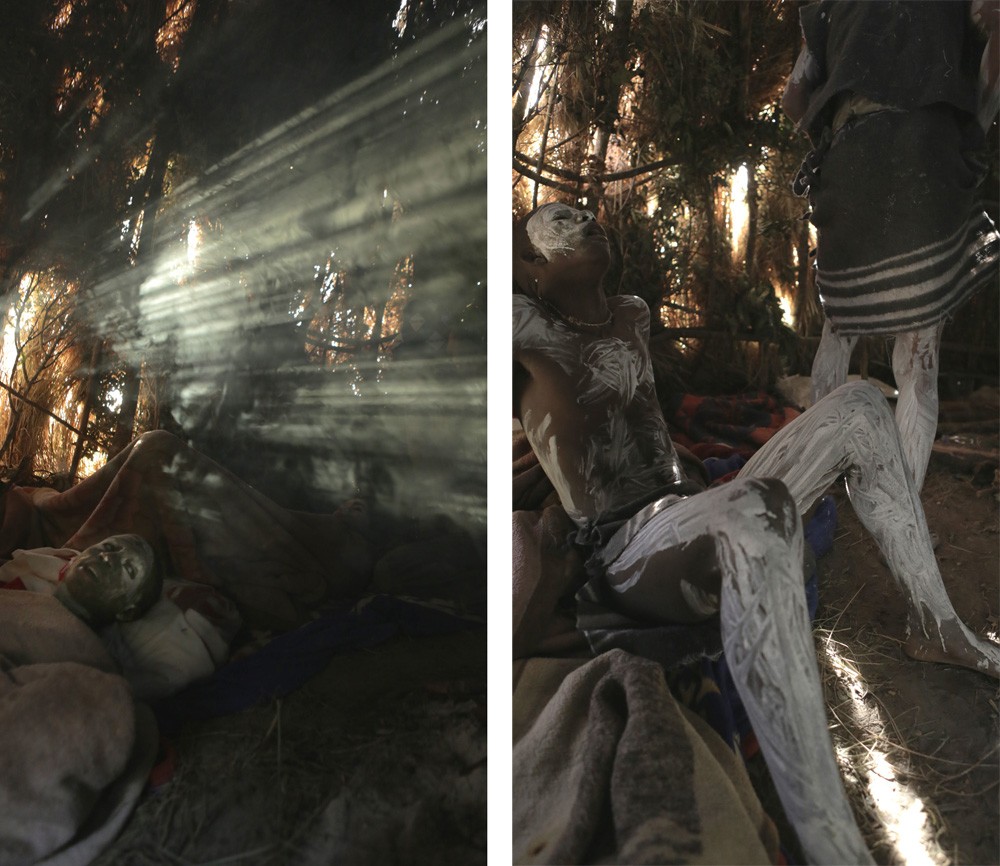
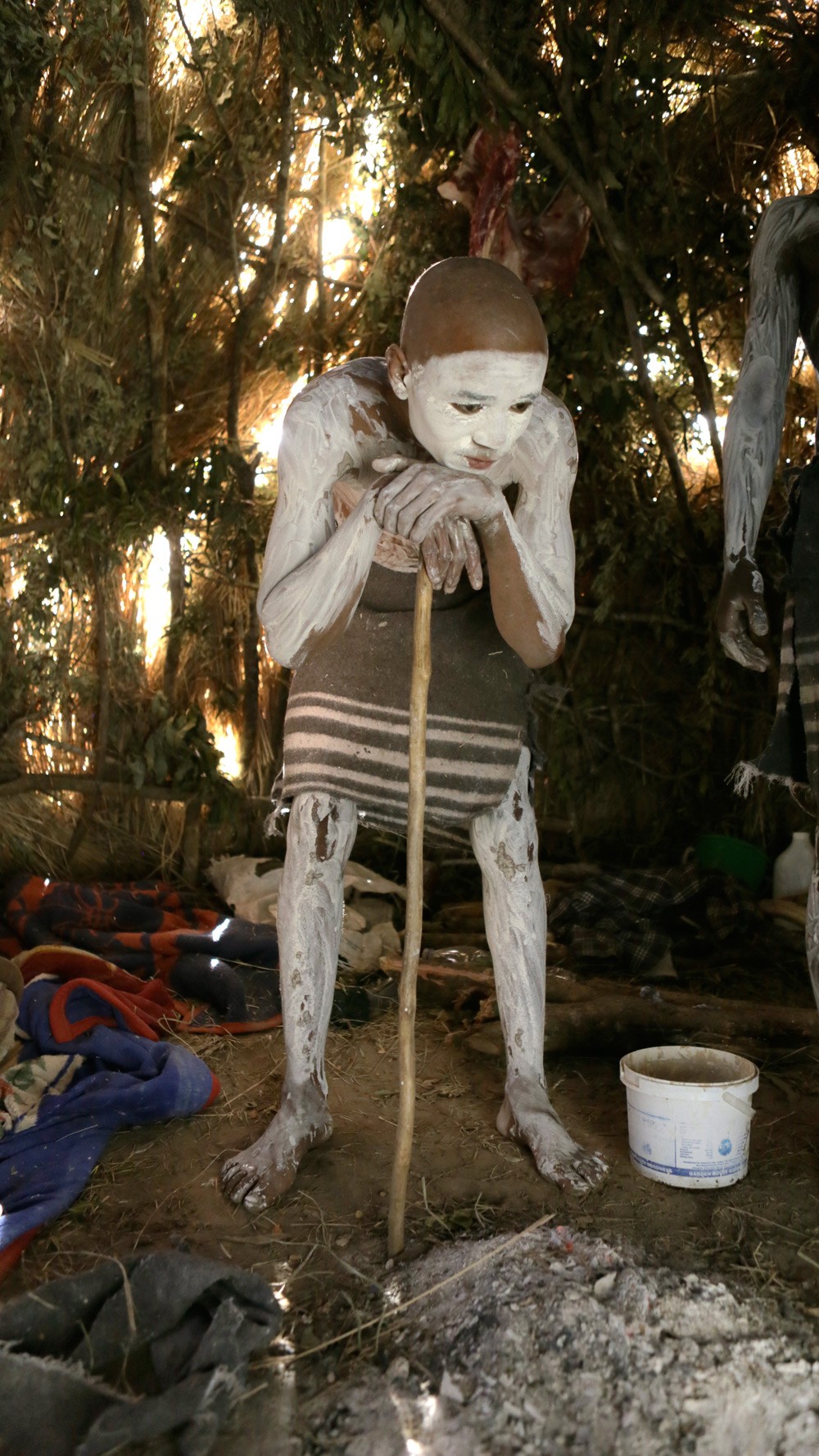
It will be two days before they are allowed water. They appear thin and weak. They tell each other stories to avoid boredom and talk about food often. Their jaws hurt from grinding half-cooked maize.
They must show vigilance in their actions. After dressing the wounds, John makes them hold the water bottle for him to wash his hands. Even though they are dying of thirst, they never complain.
They are so weak on the morning of the seventh day they can barely stand. What were once three vigorous teenagers now appear like old men, hunched over their sticks. They hardly talk as they slowly apply white clay to their bodies before leaving the iboma. A goat is slaughtered outside, and the men in attendance drink ceremonial brandy in the warm winter sun. The abakwetha are given great spoonfuls of maize meal and sour milk followed by hunks of broiled goat. Their personalities and vigour return; they begin to laugh, tell jokes and even dance.
In the following days, they go for walks to collect leaves for dressing their wounds. The big stiff leaves are rolled between two bottles to soften them for comfort. I tried to help by collecting leaves and, on offering some to Sandile, he looked at them and said, ‘Not big enough, Rich.’ I don’t think he meant to joke; he just needed bigger leaves than I would.


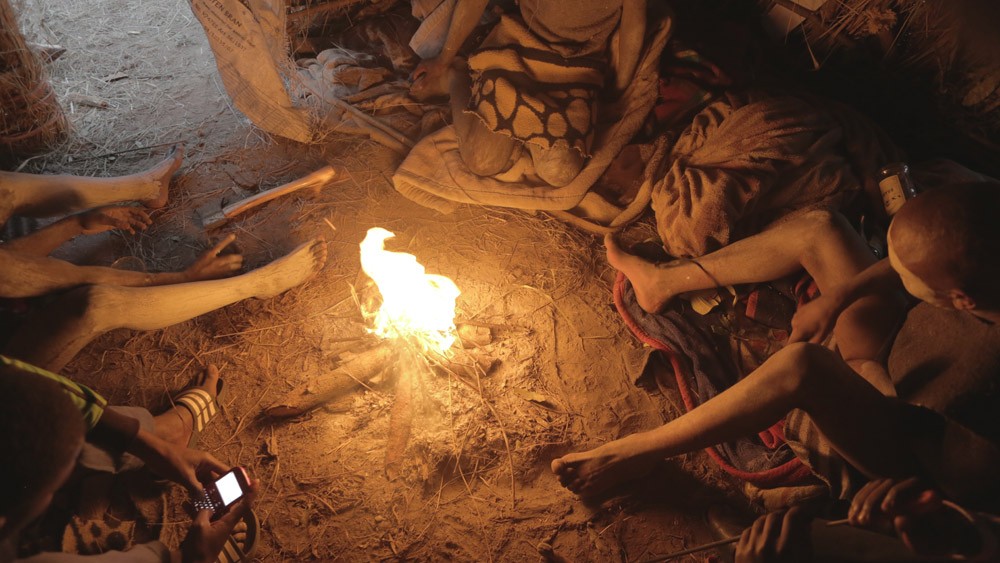
The seclusion, suffering and pain represent the trials of life
There are two other iboma built across the hills where six more abakwetha are undergoing the Ulwaluko. We went for a long walk to see how they were doing. Their iboma is very impressive. I later find out one of the boy’s fathers works for a thatching company and that he used old thatch and poles. These initiates are attended by a gaggle of their inqalathi. These micro-lumberjacks scale the thorn trees and work their machetes to keep firewood coming.
As the days pass slowly, the abakwetha walk in the hills chopping wood, teasing the inqalati and following their strict regimen. By day 20, their spirits are high. They dance, stick fight and hunt for rabbits in the bush. Their little helpers continue to devastate the thorn tree population.
The inqalathi are learning all the time. They watch all the ceremonies and learn the ‘language’ of the abakwetha, taking in with some trepidation what their rite of passage will require when it is upon them.
The verbal transfer of knowledge seems secondary to the symbolism. The seclusion, suffering and pain represent the trials of life; it is the process that matters, not what is said. It is a test of personal character and fortitude. Of course, no boy should needlessly die, but I wonder if the Xhosa people would place such a high value on the ceremony if there were zero chance of fatalities.
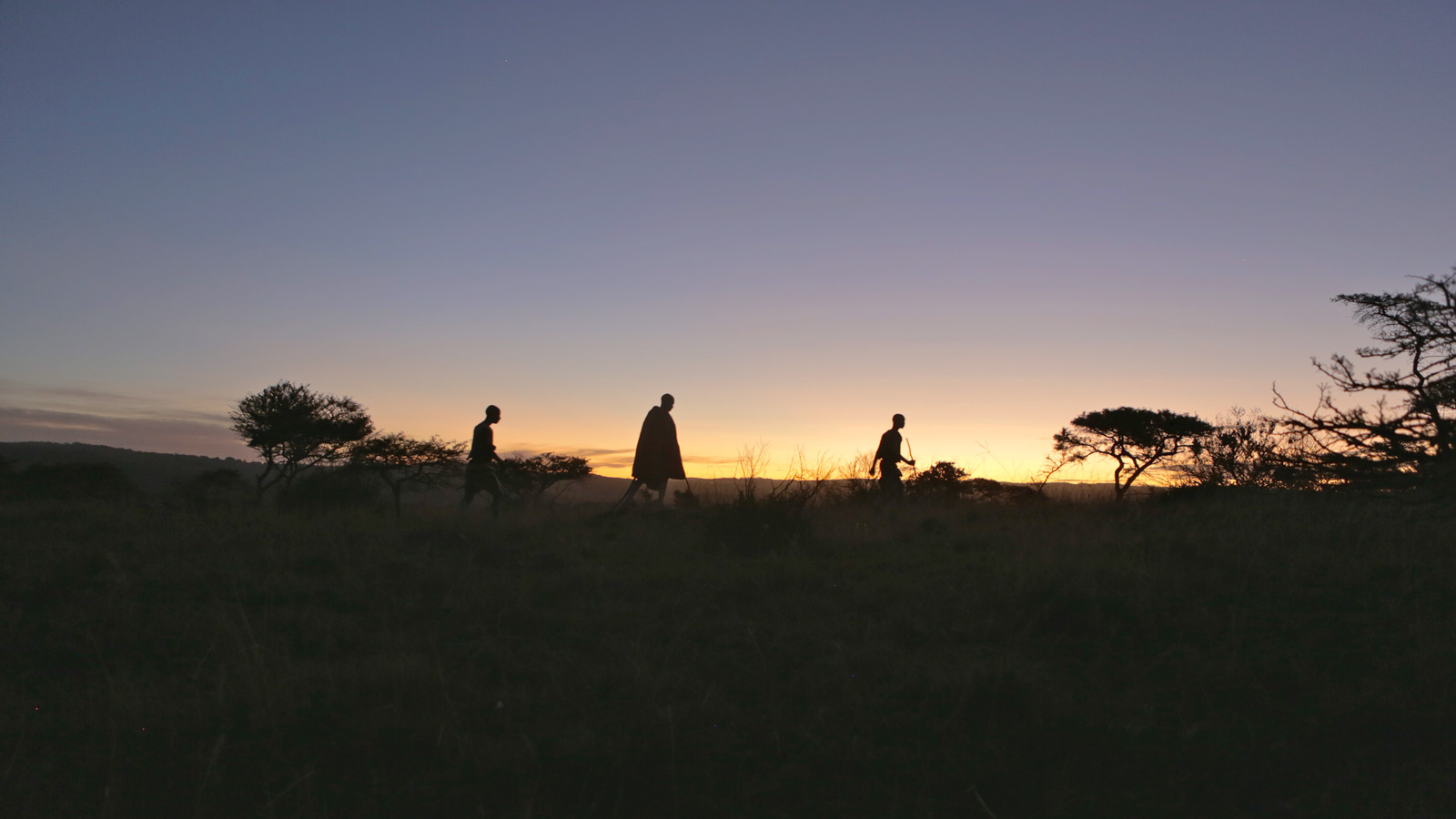
I won’t go to Makiwane
The abakwetha sing a beautiful song about their ordeal. Patrick, one of the inqalathi, translates it for me. While the backing singers repeat the phrase ‘It’s hard to be a man’, Lulama, who has a higher voice, sings the guidelines of the abakwetha. In particular, one verse is repeated: ‘I won’t go to Makiwane, no, no, no, it is not the time for Makiwane. Be quiet little boy; it’s hard to be a man.’
Cecilia Makiwane Hospital is a public hospital on the outskirts of East London. I asked them what it would take for one of them to go to the hospital. Sandile points his finger at the ground of the iboma and says, ‘We will never go. We would rather die here than go to the hospital.’
‘We will rather die here than go to hospital’
Meanwhile, the death toll for initiates stands at 35 in the Eastern Cape for this winter season, and there is still a week to go. This reluctance to seek outside help is one of the key reasons so many initiates die, but some overseers act responsibly. Last year pneumonia spread amongst initiates nearby. The supervisor blamed bad spirits in the iboma, and got all the boys proper medical attention. When they were well again, they returned to another iboma, away from the previous site. A smart application of spiritual beliefs saved the boys’ lives – and upheld tradition.
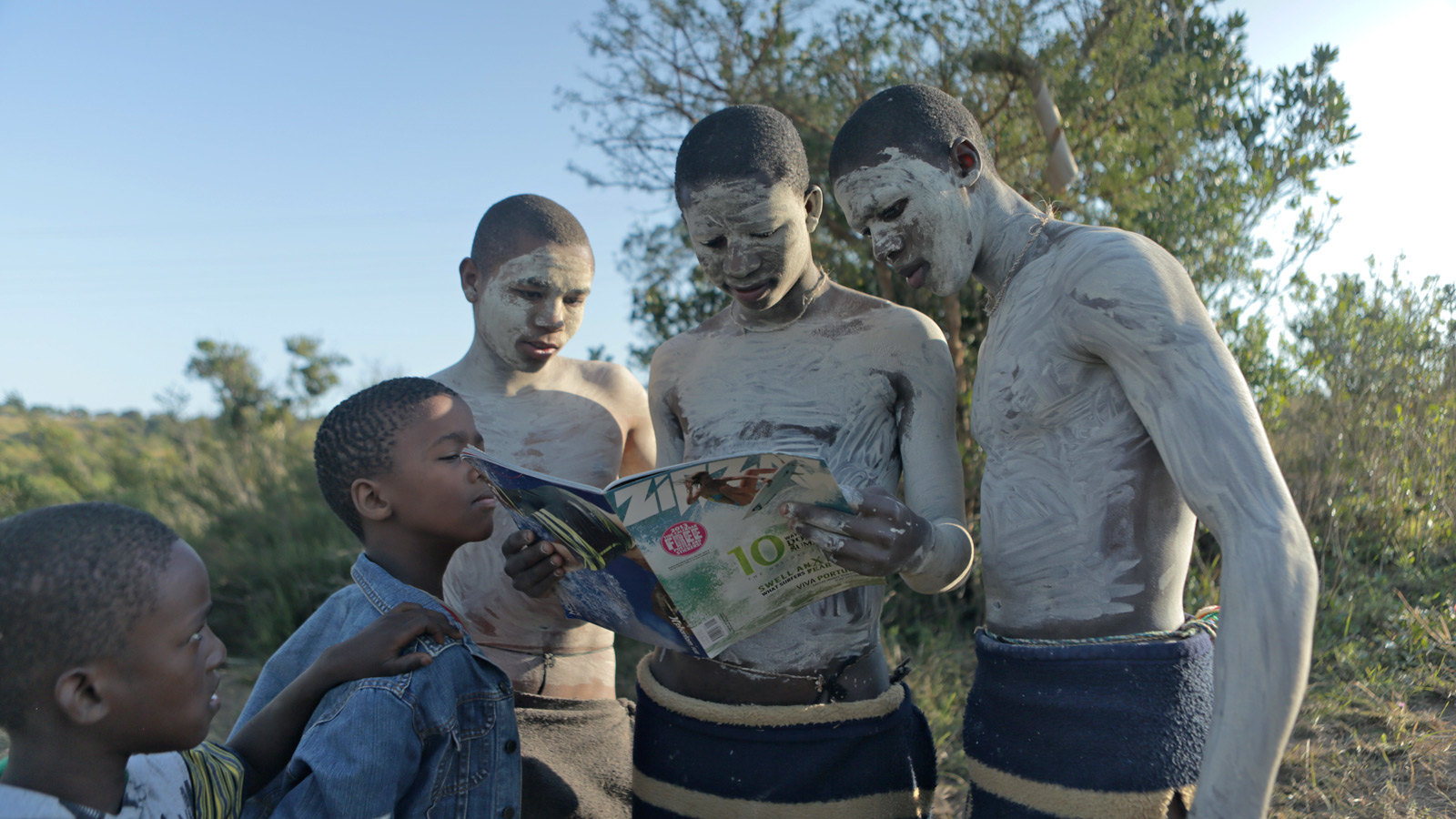

I have often filmed the abakwetha carrying out the morning ritual of applying white river clay. Today, perhaps through boredom, they adorn Anathi’s back with a giant NIKE logo – another strange clash of the traditional and the new. Lulama gets Zebra stripes on his back, and Sandile gets his girlfriend’s name. It seems rebellious. I dread to think how many whacks of the cane John might give them if he sees the NIKE logo. Maybe he won’t mind. Understanding the taboos is a minefield, and perhaps that’s the idea – to keep the abakwetha on their toes.
Their mood is high at this stage, and they count the days towards the 12th of July. I have taken to showing them videos of my children in Sydney. We all laugh; they see Charlie’s fourth birthday cake and are stunned as if they have never seen anything so amazing.
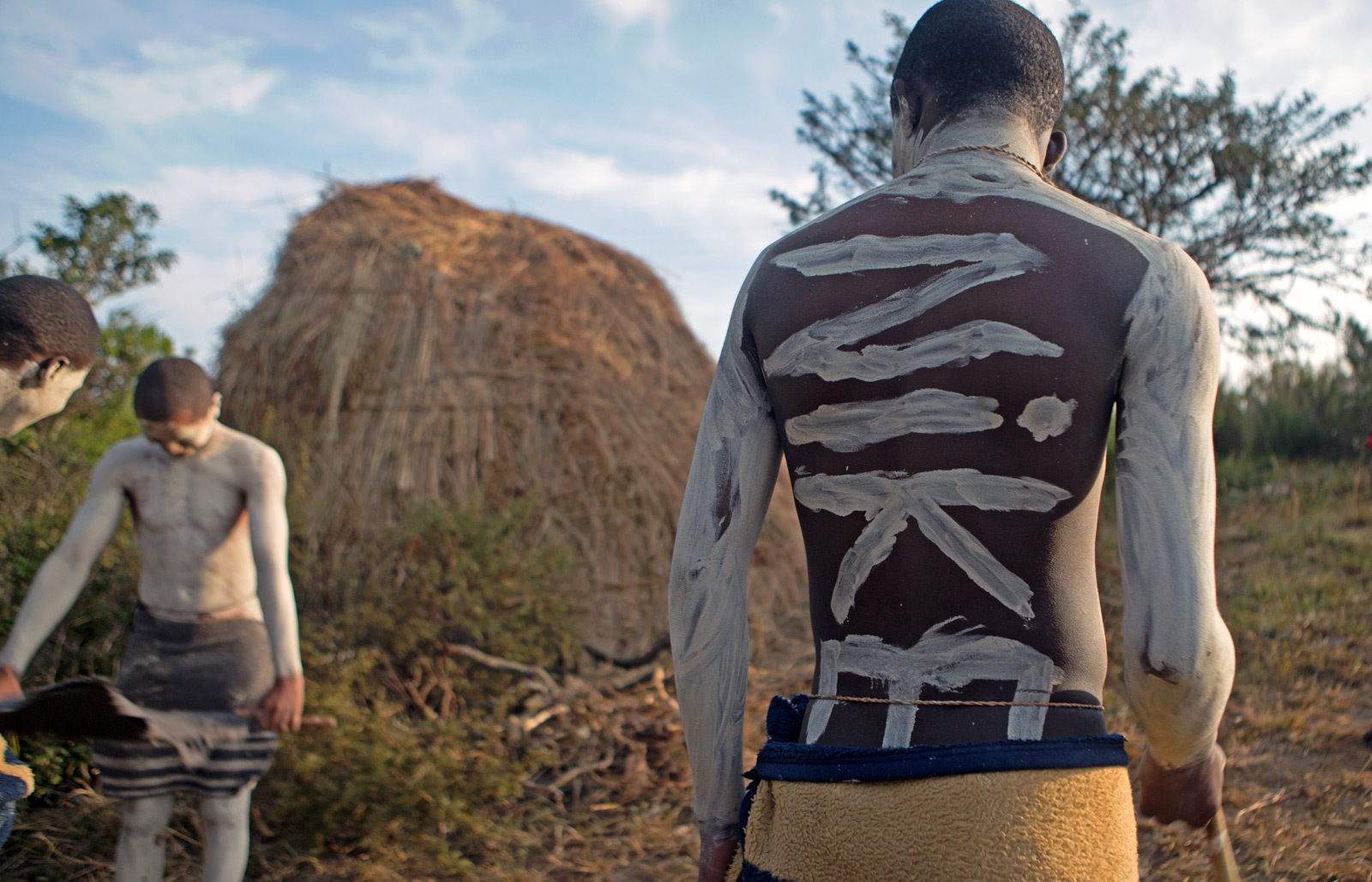
Boys to men
John and his youngest son cut palm leaves that they bend into three crowns for the initiates as a symbol that their homecoming is near. Their heads are freshly shaved, and John instructs them to shave the head of one of the inqalathi, ten-year-old Athiti. It is an honour for him, as he will serve as a mascot over the coming two days. He will lead the procession back to the village and participate as if he were an umkwetha himself.
On their final day in the bush, the abakwetha and inqalathi work hard, chopping a huge stockpile of wood. Men build a bonfire outside the iboma and play a traditional initiation game called ceya through the night. It’s played with short and long twigs concealed in each hand, accompanied by what seem to be impersonations of animals, and spirits with strange clicks and squeals. In the firelight, the wild gesticulations, explosive laughter and warmth between the men of all ages is magical. How long have men played ceya by the fire under the spectacular African night sky?
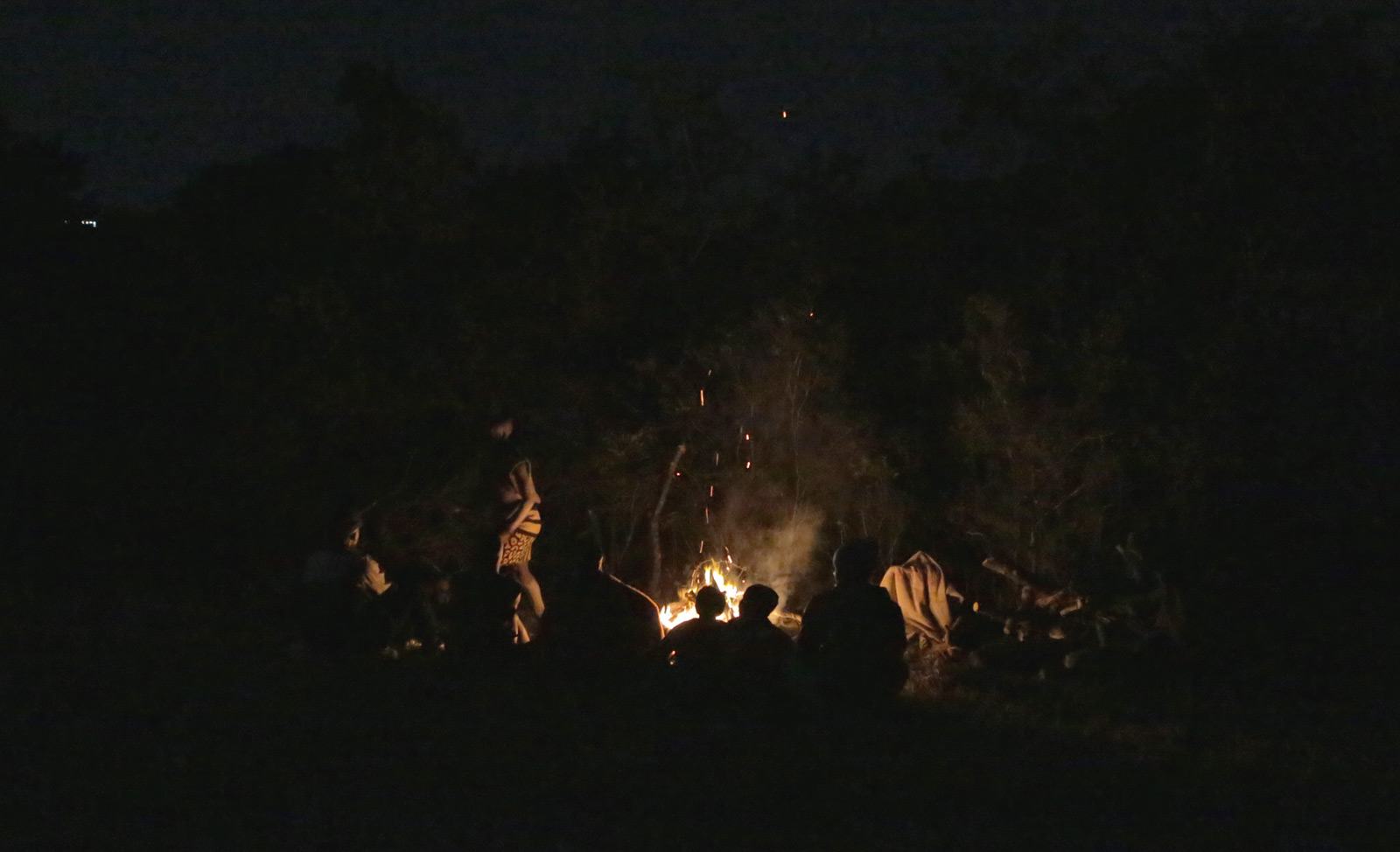
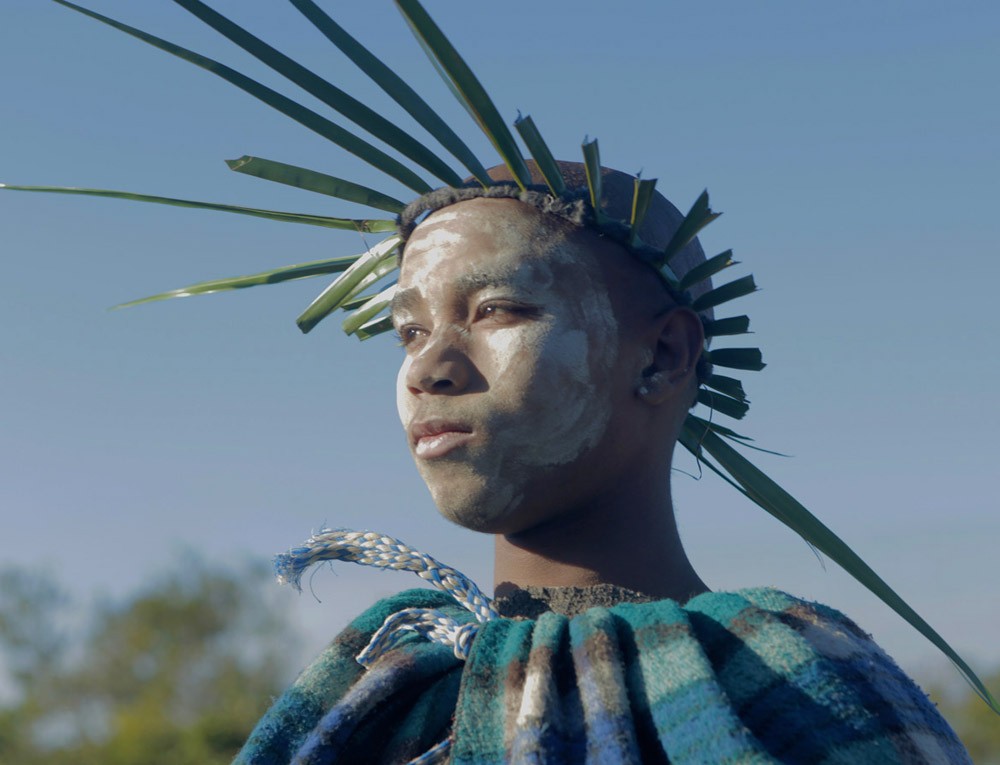

At dawn, John leads the abakwetha to the river. Before entering the water, they pay homage to the ancestors by daubing river clay on their foreheads, then they stand knee-deep and carefully wash all remnants of white clay from their bodies. In the cold morning light, they head back to camp naked. Bangile, the eldest of the Pakamile family, covers their bodies in butter. He then covers them in coloured blankets, leaving them just a tiny peephole through which they hold their black sticks.
Forming a single line behind young Athiti, they shuffle away from the iboma, where the men break into song and set the hut alight. Within minutes it is a fireball; all the trappings of the last month incinerated. The abakwetha do not look back as they walk on, followed by dozens of men, young and old. As they move through the village, women ululate, and small children join the group. When they reach the Pakamile homestead, the women beat sticks onto a corrugated iron sheet.
The boys sit outside the kraal, the little mascot Athiti at one end and an older man at the other, representing the generations. Seated around the boys are more than a dozen old men. Each of them stands to impart words of wisdom to the abakwetha. After each speech, a symbolic offering of one or two Rand coins represents the first step on a much larger journey. All I can think about is buttons with no holes.
After the speeches, the initiates are moved inside, surrounded by friends and siblings. Two girls enter and transform the boys by painting their faces with red ochre and wrapping their heads with black and white cloth. From being amakhwetha the initiates have become amakrwala. Finally, they begin to relax their stoic demeanour.
The following day, after a hearty breakfast of soup, vegetables and meat, the three amakrwala are escorted to Lulama’s rural home, a beautiful spot overlooking a pristine valley.
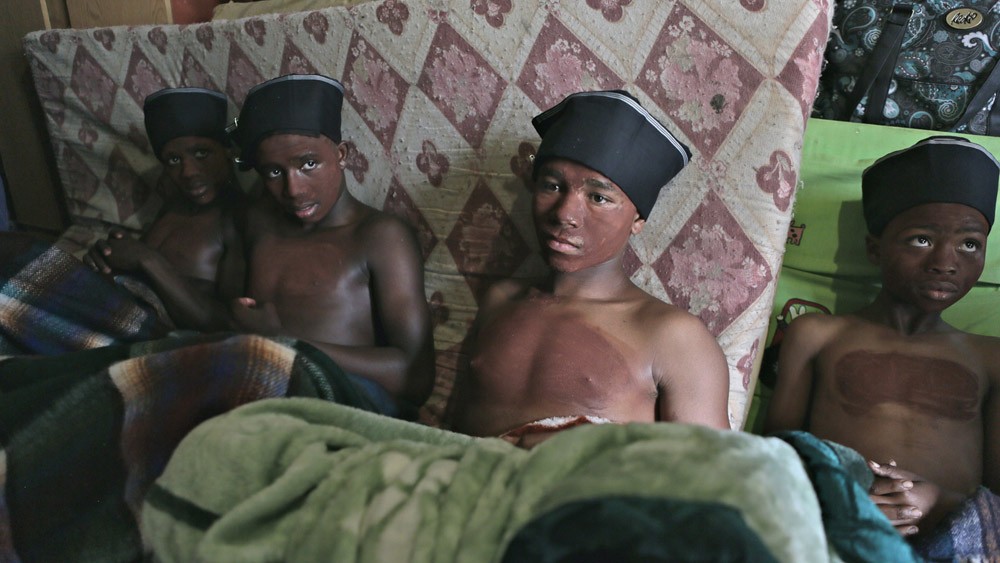
As a thank you to the overseer and the people of Chintsa village, the family slaughter a pig for their guests and mark the occasion with more brandy and beer. While family members sit in the morning sun, men butcher the pig and cook it on the open fire. The amakrwala sit in the grass, and Lulama sees his siblings for the first time in a month. At a certain point, John ushers him into a hut. Lulama washes and bathes his whole body while standing in a large enamel dish. He finally reappears in brand-new Western clothes. Lulama’s face is then smeared with a brownish paste to mark the final stage of the transition.
The entire group then travels back to Chintsa village. Sandile and Nathi wash and dress in smart flat caps, jackets, pressed trousers and leather-soled shoes. Bangile, the oldest man, embraces them and warmly slaps them on the back. There are brief speeches and ceremonial brandy shots, and it is finally over. They walk out of the hut and take their first steps on the long journey of life as men.

It’s hard to be a man
Not once did I witness fighting, drinking or disobedience from the abakwetha. Likewise, the adults in direct supervisory roles performed their duties skillfully and responsibly. Because the tradition isn’t written down or uniform across the Xhosa nation, I am sure the ceremony has many variations. I suspect the deaths and mutilations may result from badly run initiation schools. Perhaps because I have witnessed a school run well, I am biased, but people from my culture circumcise babies and voluntarily risk their lives with breast augmentation and nose jobs. We are quick to judge traditional cultures and even quicker to forget our similarities.
I loved the warmth and comfort shown by the community of men. I have never sat in communion around so many fires and seen children and adults work together so effortlessly for a common cause. All had their role, and all had respect for each other. I was shown incredible kindness and understanding and was never questioned about my presence or purpose. They trusted me. The long ceremony gave me the time to ponder my own role as a man, something Westerners like me blunder into via alcohol-fuelled 21st birthday parties.
When I asked the abakwetha why they had to go through all this, they replied: It’s hard to be a man. You can’t buy or be given it; you must be it. You have to endure pain, hunger and hardship. When times get tough in your life, you know you got through your initiation, so you can get through whatever challenge you face.
ALSO READ: Himba – a people in transition
Contributor
 Richard Bullock with the Xhosa initiates he filmed and wrote about.
Richard Bullock with the Xhosa initiates he filmed and wrote about.
Australian-born RICHARD BULLOCK began his professional life as an advertising copywriter in Sydney with Chiat/Day/Mojo. This was followed by a long stint at TBWA Hunt Lascaris in Johannesburg South Africa, where his love for the African continent took hold. Along with his South African wife, Richard travelled and worked worldwide, often returning to their second home in Chintsa on South Africa’s east coast. In 2004 he began writing and directing film projects for clients. Eventually, he crossed over from advertising to directing full-time, helming projects globally for Adidas, Sony, Amnesty, Omega, Motorola and many more. One of his unique talents is directing projects in remote and sometimes difficult locations. He has shot films about climate change in Peru, eye surgery in Mongolia, heart disease in Rwanda and plastic surgery in South Africa. His long-form films have run on the National Geographic Channel, Eurosport and the BBC. One of his latest projects involved documenting the controversial Xhosa circumcision ritual near his Chintsa home. You can see Richard’s film work here.
To comment on this story: Login (or sign up) to our app here - it's a troll-free safe place 🙂.![]()




